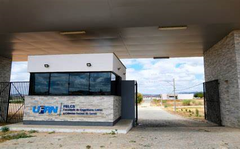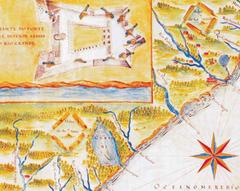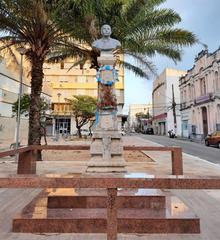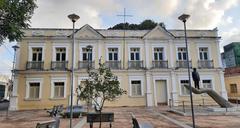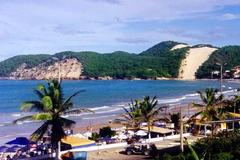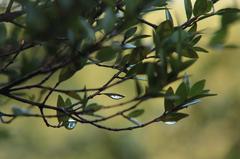Dunas De Natal State Park Visiting Hours, Tickets, and Travel Guide
Date: 04/07/2025
Introduction
Located within the vibrant city of Natal, Brazil, Dunas De Natal State Park (Parque Estadual das Dunas de Natal “Jornalista Luiz Maria Alves”) is one of the largest urban parks in the country and a sanctuary of ecological and cultural significance. Spanning roughly 1,172 hectares, this protected reserve invites visitors to explore its unique coastal dune systems, remnants of Atlantic Forest, and diverse restinga vegetation. Since its establishment in 1977, the park has become a vital biodiversity hotspot—home to over 270 plant species and more than 180 bird species—while serving as a green lung and essential groundwater recharge zone for Natal’s urban population. The park’s dunes stabilize the coastline, mitigate the urban heat island effect, and contribute to the city’s renowned clean air quality (Natal Rio Grande do Norte).
Easily accessible within Natal, Dunas De Natal offers well-marked trails, wildlife observation, and engaging educational programs. Modest entrance fees support conservation, and guided tours led by local experts reveal the park’s ecological, historical, and cultural importance. Adventure lovers can enjoy sandboarding and ziplining, while educational workshops foster environmental stewardship.
This guide provides comprehensive information on visiting hours, ticketing, ecological highlights, safety, accessibility, and nearby attractions, enabling you to make the most of your experience at one of Natal’s most treasured natural landmarks (doinbrazil.com, tempoutil.com, parquedasdunas.rn.gov.br).
Contents
- Discover Dunas De Natal State Park: A Must-Visit Natural Treasure
- Visitor Information
- Tickets and Opening Hours
- How to Get There
- Guided Tours and Activities
- What to See and Do
- Diverse Ecosystems
- Hydrological and Climatic Importance
- Cultural Connection
- Accessibility and Visitor Guidelines
- Nearby Attractions
- Frequently Asked Questions (FAQ)
- Conservation and Future Outlook
- Park Layout and Activities
- Trails and Ecological Walks
- Wildlife Observation
- Adventure Activities
- Educational Programs
- Facilities and Accessibility
- Safety and Visitor Guidelines
- Best Times to Visit
- Conservation, Research, and Community Outreach
- Conservation Initiatives
- Research Activities
- Environmental Education and Community Engagement
- Sustainable Tourism
- Summary and Visitor Recommendations
- Sources and Official Links
Discover Dunas De Natal State Park
Dunas De Natal State Park is an urban oasis offering a rare glimpse into Brazil’s coastal dune and Atlantic Forest ecosystems. Its peaceful landscapes, abundant wildlife, and rich cultural history make it an essential destination for nature lovers, outdoor adventurers, and families. Managed by IDEMA-RN and protected by local and national legislation, the park stands as a model of urban conservation and sustainable tourism.
Visitor Information
Tickets and Opening Hours
- Opening Hours: The park is generally open Tuesday through Sunday, from 7:00 AM to 5:30 PM (closed Mondays for maintenance). On some days, hours may vary slightly—always check the official website for current details.
- Entrance Fees: Admission is typically around BRL 5 for adults and BRL 2.50 for students and seniors; children under 7 enter free. Some educational programs or guided tours may require an additional fee.
- Where to Buy Tickets: Tickets are available at the main entrance or online via the official site.
How to Get There
Dunas De Natal State Park is centrally located in Natal and is accessible by car, taxi, rideshare, or public transportation. The main entrance is at Av. Alm. Alexandrino de Alencar, s/n - Tirol, Natal - RN, Brazil. Ample parking is available, and several bus lines serve the area.
Guided Tours and Activities
The park offers guided nature walks, birdwatching tours, and educational programs. Booking in advance is recommended, particularly during weekends and holidays. English-language tours may be available upon request.
What to See and Do
Diverse Ecosystems
Explore a mosaic of rolling white dunes, lush Atlantic rainforest, and restinga shrubland. Well-marked trails lead you through habitats supporting bromeliads, orchids, endemic trees, and a remarkable variety of wildlife.
Hydrological and Climatic Importance
The park’s dunes act as natural aquifers, recharging Natal’s water supply and stabilizing the coastline. Vegetation helps reduce urban heat and prevent sand encroachment.
Cultural Connection
The park is woven into Natal’s cultural fabric, hosting community events, folklore celebrations, and environmental workshops that connect visitors with the region’s history.
Accessibility and Visitor Guidelines
- Facilities: Visitor center, restrooms, drinking fountains, picnic areas, and parking are provided.
- Accessibility: Main trails and the visitor center are wheelchair-friendly, though some dune areas may be challenging for those with limited mobility.
- Visitor Guidelines:
- Stay on marked trails to avoid ecosystem damage.
- Carry out all trash; littering is prohibited.
- Fires, barbecues, and camping are not allowed.
- Pets are not permitted to protect wildlife.
- Recreational activities (e.g., sandboarding, ziplining) are available in designated zones and subject to weather conditions.
Park Layout and Activities
Trails and Ecological Walks
Choose from family-friendly to challenging guided trails:
- Peroba Trail: Short, accessible, and great for beginners.
- Ubaia-Doce Trail: Moderate, with birdwatching opportunities.
- Perobinha Trail: Long and more adventurous, traversing dunes and forest.
Interpretive signage enhances the learning experience.
Wildlife Observation
Birdwatchers can spot over 270 species, including tanagers, thrushes, hummingbirds, and more. Mammals like marmosets and armadillos, plus reptiles and insects, make each walk a discovery.
Adventure Activities
- Sandboarding (Skibunda): Slide down the dunes on a sandboard—fun for all ages, with equipment rentals available.
- Ziplining (Aerobunda): Glide from dune peaks into freshwater lagoons, supervised by trained staff.
Educational Programs
The visitor center features interactive exhibits, and the park regularly hosts workshops and school programs in Portuguese (English on request).
Safety and Best Times to Visit
- Safety: Rangers patrol the park, and first aid is available. For emergencies, the nearest hospital is a short drive away.
- Best Time to Visit: The dry season (August–January) offers the best weather. Early mornings and weekdays are quieter; weekends and holidays tend to be busier.
Nearby Attractions
Enhance your visit by exploring:
- Ponta Negra Beach: Home to the iconic Morro do Careca dune.
- Forte dos Reis Magos: A historic fortress with panoramic views.
- Natal Historic Center: Colonial architecture and bustling markets.
The park’s location makes it an ideal starting point for broader Natal explorations.
Conservation, Research, and Community Engagement
Conservation Initiatives
Managed by IDEMA-RN, the park enforces strict protections on land use and supports ongoing habitat restoration and biodiversity monitoring (doinbrazil.com).
Research Activities
Local universities conduct studies on dune stabilization, hydrology, and biodiversity, informing management and conservation strategies (tempoutil.com).
Environmental Education and Community Outreach
- Interpretive trails and visitor center exhibits foster public understanding.
- School programs, community collaborations, and volunteer opportunities promote stewardship and social inclusion.
- NGOs such as Instituto Navegar participate in awareness and restoration projects.
Sustainable Tourism
Visitor numbers and environmental indicators are monitored to ensure responsible recreation. Guidelines are in place to minimize ecological impact and maintain the park’s long-term health.
Frequently Asked Questions (FAQ)
Q: What are the park’s opening hours?
A: Generally open Tuesday–Sunday, 7:00 AM–5:30 PM. Closed Monday for maintenance.
Q: How much is the entrance fee?
A: Around BRL 5 for adults, BRL 2.50 for students and seniors, free for children under 7.
Q: Are guided tours available?
A: Yes, in Portuguese and sometimes English. Book in advance if possible.
Q: Is parking available?
A: Yes, free parking is available at the main entrance.
Q: Are pets allowed?
A: No, to protect native wildlife.
Q: Is the park accessible for visitors with limited mobility?
A: Main facilities and some trails are accessible; check with the visitor center for details.
Summary & Recommendations
Dunas De Natal State Park is a model of urban conservation, offering an immersive experience in Brazil’s coastal ecosystems and cultural heritage. With accessible trails, affordable entrance, guided tours, educational programs, and safe adventure activities, the park caters to a wide range of interests. Its commitment to research, community engagement, and sustainable tourism ensures resilience against environmental pressures. For the best experience, consult official resources, respect visitor guidelines, and consider booking guided activities. Use the Audiala mobile app for real-time updates and insider tips.
Sources and Further Information
- Dunas De Natal State Park: Visiting Hours, Tickets, and What to See in Natal’s Historic Dunes, 2025, IDEMA-RN (https://parquedasdunas.rn.gov.br)
- Visiting Dunas de Natal State Park: Hours, Tickets, and Ecological Significance, 2025, Inner Brazil (https://www.innerbrazil.com/en/20-fun-things-to-do-in-natal/)
- Dunas De Natal State Park Visiting Hours, Tickets, and Things to Do in Natal, 2025, Official Park Website (https://parquedasdunas.rn.gov.br)
- Conservation, Research, and Community Outreach, 2025, doinbrazil.com (https://doinbrazil.com/natal-rio-grande-do-norte-brazil/)
- Conservation, Research, and Community Outreach, 2025, tempoutil.com (https://tempoutil.com/2025/04/17/natal-tourism-3/)
- Natal Rio Grande do Norte: Weather and Environmental Quality, 2025 (https://www.natalriograndedonorte.com/weather-in-natal-brazil/)

